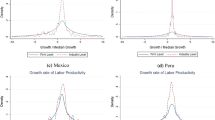Abstract
This article investigates the impact of government industrial policy and trade protection of the manufacturing sector in Korea. Empirical results are provided, using four-period panel data for the years 1963 through 1983, for thirty-eight Korean industries in which trade protection reduced growth rates of labor productivity and total factor productivity, while industrial policies, such as tax incentives and subsidized credit, were not correlated with total factor productivity growth in the promoted sectors. The evidence thus implies that less government intervention in trade is linked to higher productivity growth.
Similar content being viewed by others
References
Amsden, A. H. (1989). Asia's Next Giant: South Korea and Late Industrialization. New York: Oxford University Press.
Balassa, B. (1988). “The Lessons of East Asian Development: An Overview”. Economic Development and Cultural Change 36, S273-S290.
Barro, R., and J. W. Lee. (1994). “Sources of Economic Growth”. Carnegie-Rochester Conference Series on Public Policy 40, 1–46.
Barro, R., and X. Sala-i-Martin. (1995). Economic Growth. New York: McGraw-Hill.
Bhagwati, J. (1978). Foreign Trade Regimes and Economic Development: Anatomy and Consequences of Exchange Control Regimes. New York: National Bureau of Economic Research.
Choo, H., Y. Kim, and C. Yoon. (1982). Korean Capital Stock Estimates, 1960–1977, in Korean. Seoul: Korea Development Institute.
Collins, S. M., and W. A. Park. (1989). “External Debt and Macroeconomic Performance in South Korea”. In J. Sachs and S. Collins (eds.), Developing Country Debt and Economic Performance. Chicago: University of Chicago Press.
Dollar, D., and K. Sokoloff. (1990). “Patterns of Productivity Growth in South Korean Manufacturing Industries, 1963–1979”. Journal of Development Economics 33, 309–327.
Dornbusch, R., and Y. C. Park. (1987). “Korea Growth Policy”. Brookings Papers on Economic Activity 2, 389–444.
Frank, C. R., K. S. Kim, and L. E. Westphal. (1975). Foreign Trade Regimes and Economic Development: South Korea. New York: National Bureau of Economic Research.
Havrylyshyn, O. (1990). “Trade Policy and Productivity Gains in Developing Countries”. World Bank Research Observer 5, 1–24.
Hong, W. T. (1979). Trade Distortions and Employment Growth in Korea. Seoul: Korea Development Institute.
Jorgenson, D. W., and M. A. Sullivan. (1981). “Inflation and Corporate Capital Recovery”. In C. R. Hulten (ed.), Depreciation, Inflation, and Taxation of Income from Capital. Washington, DC: Urban Institute Press.
Kim, K. H., and D. Leipziger. (1993). Korea: A Case of Government Led Development. World Bank Country Study. Washington, DC: World Bank.
Kim, K. S. (1988). Economic Effects of Import Liberalization and Industry Adjustment Policies (in Korean). Seoul: Korea Development Institute.
Kim, K. S., and S. Park. (1988). Analysis of Productivity Change and Its Causes in the Korean Manufacturing (in Korean). Seoul: Korea Institute for Economics and Technology.
Kim, K. S. and L. E. Westphal. (1976). The Exchange and Trade Policies of Korea. Seoul: Korea Development Institute.
Krueger, A. (1978). Foreign Trade Regimes and Economic Development: Liberalization Attempts and Consequences. New York: National Bureau of Economic Research.
Krueger, A. (1985). “The Experience and Lessons of Asia's Super Exporters”. In Corbo et al. (eds.), Export-Oriented Development Strategies. Boulder, CO: West View Press.
Krueger, A. (1990). “Asian Trade and Growth Lessons”. American Economic Review 80, 108–111.
Kwack, T. W. (1985). Depreciation System and Capital Gain Tax (in Korean). Seoul: Korea Development Institute.
Lal, D. (1985). The Poverty of Development Economics. Cambridge, MA: Harvard University Press.
Lee, J. W. (1993). “International Trade, Distortions, and Long-Run Economic Growth”. IMF Staff Papers 40, 299–321.
Mankiw, N. G., D. Romer, and D. N. Weil (1992). “A Contribution to the Empirics of Economic Growth”. Quarterly Journal of Economics 107, 407–437.
Mason, E., M. J. Kim, D. Perkins, K. S. Kim, and D. Cole. (1980). The Economic and Social Modernization of the Republic of Korea. Cambridge, MA: Harvard University Press.
Nam, C. H. (1981). “Trade, Industrial Policies and the Structure of the Protection in Korea”. In W. T. Hong, and L. Krause (eds.), Trade and Growth in Advanced Developing Countries in the Pacific Basin. Seoul: Korea Development Institute.
Nishimizu, M., and S. Robinson. (1984). “Trade Policies and Productivity Change in Semi-Industrialized Countries”. Journal of Development Economics 16, 177–206.
Pack, H. and L. E. Westphal. (1986). “Industrial Strategy and Technological Change: Theory versus Reality”. Journal of Development Economics 22, 87–128.
Rodrik, D. (1995). “Trade, Industrial Policy Reform”. In J. Behrman, and T. N. Srinivasan (eds.), Handbook of Development Economics (vol. 3B). Amsterdam: Elsevier Science.
World Bank. (1991). World Development Report 1991. New York: Oxford University Press.
World Bank. (1993). The East Asian Miracle: Economic Growth and Public Policy. New York: Oxford University Press.
Young, A. (1993). “Invention and Bounded Learning by Doing”. Journal of Political Economy 101, 443–472.
Young, A. (1995). “The Tyranny of Numbers: Confronting the Statistical Realities of the East Asian Growth Experience”. Quarterly Journal of Economics 110, 641–680.
Young, S. G. (1992). “Import Liberalization and Industrial Adjustment in Korea”. In V. Corbo, and S. M. Suh (eds.), Structural Adjustment in a Newly Industrialized Country: The Korean Experience. Baltimore: Johns Hopkins University Press, published for the World Bank.
Author information
Authors and Affiliations
Rights and permissions
About this article
Cite this article
Lee, JW. Government interventions and productivity growth. J Econ Growth 1, 391–414 (1996). https://doi.org/10.1007/BF00141045
Issue Date:
DOI: https://doi.org/10.1007/BF00141045




